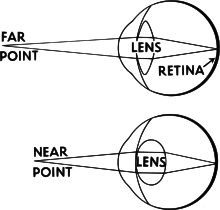
Back Akkommodasie (oog) Afrikaans تكيف (عين) Arabic Akkomodasiya (biologiya) Azerbaijani Акомодация Bulgarian Akomodacija (oko) BS Acomodació (ull) Catalan Akomodace Czech Akkommodation (øje) Danish Akkommodation (Auge) German Acomodación (ojo) Spanish


Accommodation is the process by which the vertebrate eye changes optical power to maintain a clear image or focus on an object as its distance varies. In this, distances vary for individuals from the far point—the maximum distance from the eye for which a clear image of an object can be seen, to the near point—the minimum distance for a clear image. Accommodation usually acts like a reflex, including part of the accommodation-convergence reflex, but it can also be consciously controlled.
The main ways animals may change focus are:
- Changing the shape of the lens.
- Changing the position of the lens relative to the retina.
- Changing the axial length of the eyeball.
- Changing the shape of the cornea.